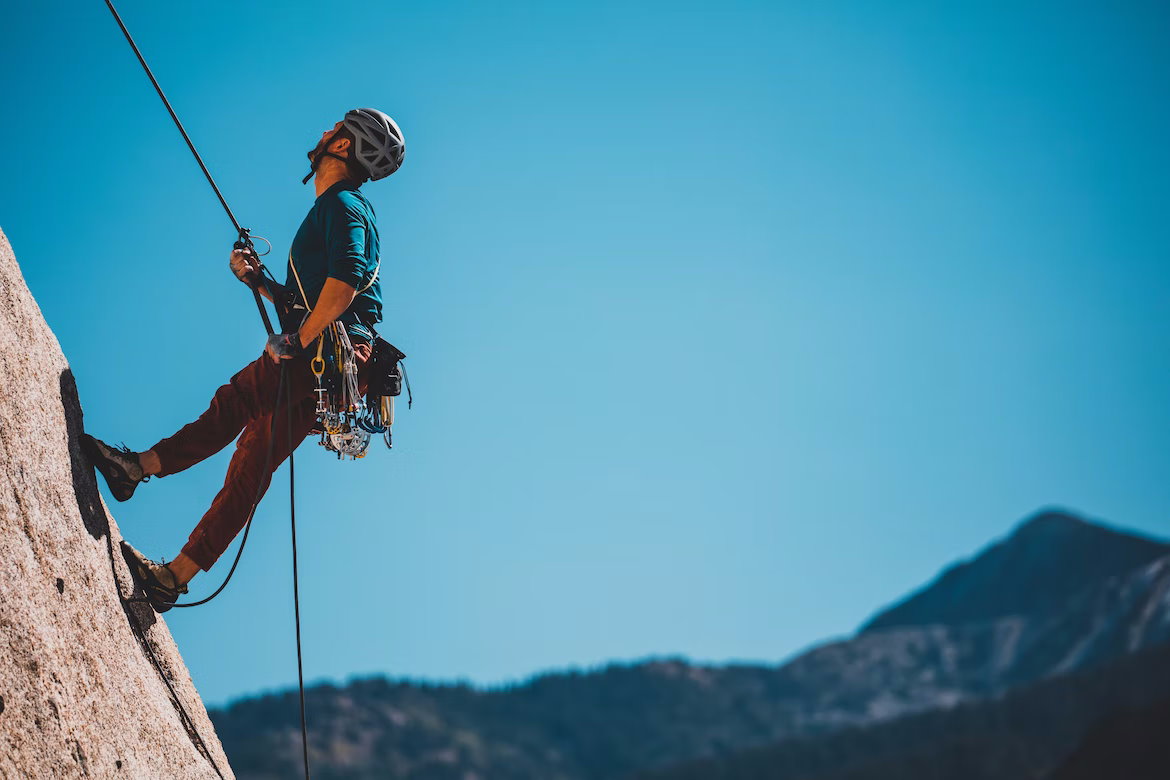On the surface, you might think climbing is the worst possible hobby for someone with acrophobia to pursue. Why, after all, would you want to spend your time scaling mountains if you can’t bear the idea of being away from the ground? Despite this, plenty of people with a fear of heights find themselves drawn to climbing.
Whether you develop anxiety around heights well into your climbing experience, or you have the phobia but yearn to take up the hobby, Climb Above Fear can help. Check out our advice on how to deal with a fear of heights while climbing.
Acrophobia and climbing
While obviously not an ideal combination, it is perfectly possible to love climbing and hate heights. According to some climbers, it’s actually pretty common! Here’s what Reddit user Hropkey posted to the site’s climbing community:
“I am terrified of heights. I also started climbing a few months ago and I love it. These two things are starting to come in conflict [sic]. The thing is, it feels like every other person I’ve met at the climbing gym is also afraid of heights.”
Sounds strange, right? Well, some people with a fear of heights actively decide to take up climbing as a way to overcome their phobia. This requires a lot of courage and commitment, but it can really pay off! (It goes without saying, though, that this approach is not really possible for those with extreme acrophobia.)
What brings about the fear?
There are a few aspects of climbing that may cause people to feel anxious. For starters, it involves moving further and further away from the ground, often without a sturdy platform to rely on—a scenario that would trigger many people with a fear of heights. Even routes such as a via ferrata, which offer climbers rungs and rails to make ascents easier, can prove terrifying, meaning that you may want to avoid destinations such as Peru’s Skylodge with acrophobia.
And the fun doesn’t stop there. Climbing can also increase a person’s fear of falling, fear of getting stuck and fear of exposure. This is an adrenaline-pumping activity, and it’s very easy for that thrilling sensation to morph into feelings of anxiety. We should also acknowledge that a fear of heights is hardly irrational when it comes to climbing. Navigating steep walls and mountains does carry risks.
The problem is, fear can actually make climbing more dangerous because panic influences our sense of balance and coordination. It’s really important, then, that you learn how to control your anxiety when embarking on a climb.
Types of climbing

Before we launch into tips to help you manage your anxiety while climbing, you might want to consider which style of the activity is most appealing to you. You can always try out a few approaches before selecting your favourite. Popular styles of climbing include:
Top roping
This is a good style for beginners. The rope is secured to a point above the climbers’ heads and runs down in two strands—one for the climber and the other for the belayer (the person controlling the safety rope). The nature of this set-up means that you will never fall far, which makes top roping less daunting than other forms of climbing.
Lead climbing
Lead climbing involves taking the rope with you as you climb and clipping it as you go. The belayer cannot offer as much assistance as they can in top roping, but this technique offers more flexibility in terms of the types of climbs you can do. It is more risky, but also more rewarding.
Bouldering
This approach does not require as much training and usually takes place closer to the ground, with the climber completing shorter routes called ‘problems’. Keep in mind that bouldering does not usually involve the use of ropes, but implements crash pads instead. This means that falls are more frequent, so avoid bouldering if falling is a big fear for you.
How to overcome a fear of heights while climbing
Build up your knowledge and skills
As with most things, when it comes to climbing, the more you do it the more comfortable you should get with it. Before you even hit that gym or crag, though, you can give yourself a head start by increasing your climbing knowledge. Learn about the best equipment, study common techniques and get comfortable with the lingo.
Doing your research beforehand should make you feel somewhat prepared when you start putting theory into practice. It should also reveal to you the many safety features that are in place to protect you from harm. Learning about belaying, for example, should serve as a reminder that climbing is much safer than it sometimes looks to outsiders.
Find the right climbing buddy

Climbing can be a great group activity. While some professionals choose to go it alone, it’s much safer to climb with someone who is more experienced than you, especially if you have a fear of heights. You’re also much more likely to improve your abilities if you climb with somebody who really knows what they’re doing.
When looking for the right climbing buddy, there are two qualities in particular you should look for. First, they should be someone you trust. Even if you haven’t known them for very long, this is the person who will be watching your back and preventing you from falling. You therefore need to ensure that you have confidence in their ability to do so.
Secondly, you need to have good communication with this person. When you’re halfway up a mountain, it’s easy to misread signals or struggle to understand what someone’s saying. Make sure your climbing buddy is a person with whom you have clear interactions and whose temperament complements yours.
DIY exposure therapy
Climbing provides the opportunity to create your own version of exposure therapy. This means gradually putting yourself in increasingly fear-inducing scenarios. For example, on day 1 you might climb 10 feet up a wall and stop. On day 2 you might try to reach 12 feet, and so on until you are able to reach the summit without giving up. This kind of gradual and repetitive exposure can eventually desensitise you to heights.
It’s really important when trying this approach that you start small and build up to new goals slowly. Trying something too scary too soon runs the risk of overwhelming you, which could make your phobia more severe than it was before.
Here’s a few tips to consider when trying this technique:
- Start on indoor walls with good safety equipment and the supervision of others.
- When you reach a height you can manage, take a few moments to be still and acknowledge any feelings you are experiencing.
- Don’t get annoyed with yourself if you don’t meet a particular session’s goal. Slow and steady is the key.
- Visualise yourself reaching new heights with ease before trying it for real.
- Don’t be put off by an injury. These can occur in any physical activities and should not be taken as a sign that your irrational level of fear is valid.
Practise falling
One of the main aspects of climbing that you might fear is falling. The reality is that this is probably going to happen at some point. It might even happen multiple times. Thankfully, though, you’ll have a rope system in place that should prevent you from falling far or getting hurt.
The best way to reduce this fear is to practise falling. Yep—more exposure therapy! Completing various falls in a controlled environment should take away any fear of the unknown and enable you to learn the top techniques to fall safely. Start in a gym with crash mats, and maybe progress to doing short falls from crags by clipping your rope to a secure anchor and dropping. As with the climbing exposure therapy, start with short drops and build up to longer falls.
Don’t look down
It’s a classic for a reason. Once you’ve built up knowledge and practice and you’re hitting the climbing walls frequently, a golden rule is to not look down. Even pro climbers without a fear of heights will often avoid doing so, because it can break their concentration.
Focus is also a vital tool for those with a fear of heights to use to their advantage. If you’re busy concentrating on what’s in front of you and how to manoeuvre even higher, you are distracted from fear. Indeed, a lot of people are drawn to climbing precisely because of the calm, present state of mind that it encourages. Looking down can cause dizziness, balance issues and anxiety, so avoid it as much as possible.
Get to the root of your fears
Finally, if you really want to overcome a fear of heights while climbing, you should explore what exactly it is that you’re afraid of. By unpicking the reasoning behind your fear you can start to understand where it came from and how it should be dealt with.
This can be easier said than done. Sometimes the root cause of a phobia is buried deep within our unconscious mind. However, that doesn’t mean you should give up as soon as it gets confusing or uncomfortable to think about. A good way to start is by categorising your thoughts, as they appear, as either rational or irrational. If they’re rational, acknowledge them while reminding yourself that this still doesn’t make them likely to come true. If they’re irrational, counter them with logical reasoning that takes the sting out of them.
You might find that studying acrophobia itself, including common symptoms, causes and impacts, will help you to better manage your own situation. There are lots of useful articles on the topic available at the Climb Above Fear blog.
Fear of heights while climbing

Learning to climb when you have a fear of heights is no easy feat. However, with the above tips in your back pocket it’s certainly not impossible. If you do manage to make it a hobby, climbing could hold the key to overcoming your acrophobia for good!
If your fear of heights is holding you back from even attempting climbing, the best solution is to seek the advice of a professional therapist. To get started or learn more about your options, get in touch with Climb Above Fear today.



